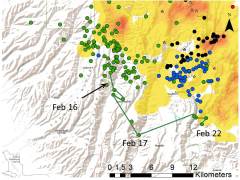Yesterday we were able to get a little flight time in one of the CDFG’s airplanes (post picture). The flights are crucial in that we cover the entire study area (and beyond) far more quickly and efficiently than is possible on the ground. This allows us to find animals that have wandered into areas we don’t (or can’t) normally search. It also is a great opportunity to see the study area from a different perspective and that is often a very good thing.
The downside is that frankly I don’t much enjoy these flights. When we first began the project the prospect of flying in an airplane or helicopter looking for animals seemed extremely exiting. Well, that excitement wore out after about flight number two. A flight entails hours of listening to static over the ear phones. It is cramped and often it is either too hot or too cold. When you do hear something the pilot (who does a wonderful job but probably doesn’t enjoy telemetry flights all that much either) promptly turns sharply so we don’t “loose” the signal and then circles until we feel confident that we have a reasonable location on the animal. I’d like to tell you that I’m so tough that I’ve never felt the tiniest amount of motion sickness during all this, but I’d be a big liar! One out of every three flights I start feeling a little green somewhere along the way. Usually, this occurs when we’ve been doing circle after circle for about 3 hours.
Yesterday’s flight was a mixed bag. We found 14 animals (that’s about 30 circles) of 21 that I was looking for. You can get a rough idea of where animal are by looking for the circles on the included maps of our track logs. Unfortunately, the day was cut a little short because we detected a mortality signal of female 1E03E near Highway 36. Beings that this needed to be investigated we didn’t spend as much time searching for all animals as I would have liked. Additionally, this was “one of those flights” where I don’t feel too well by the end of it.
Sadly, the day didn’t end any better because the mortality signal turned out to real (meaning there was indeed a dead animal). We don’t know what killed this female but we are investigating possible causes like predation. Hopefully, we’ll know more soon. We probably would not have found this mortality without the flight – or at least not for a long time. So, despite any personal comfort problems that the flight present, they are extremely important for us to continue and get as often as we can.
-ANF-
























